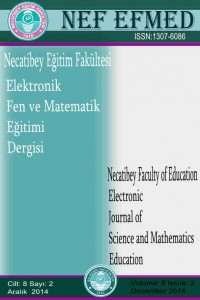Abstract
– The aim of this study is investigating the impacts of a secondary school science exhibition on the students in charge in the exhibition. For this aim, researchers did the participant open observation and made semi structured interviews with 9 students in order to gather data. The data that was obtained from the interviews was analyzed with the content analysis method. Furthermore, the data that was obtained from the observations was used to compare with the data obtained from the interviews to see whether they show consistency or not. At the end of the analyses, 15 codes were determined for the positive impacts of the exhibition process on the students in charge and these codes were gathered under 4 categories. These categories were communication, positive emotions/abilities, awareness and knowledge. Besides, 10 codes were determined for the negative impacts of the exhibition on the students in charge and these codes were gathered under 4 different categories. These were teacher, audience, physical environment and student based reasons. What’s more, research results show that the data obtained from the interviews and the observations shows consistency. When, the negative impacts of the exhibition on the students in charge was considered, it was seen that teachers who organizes exhibition has principle roles and responsibilities and with the help of the teachers most of the negative effects can be destroyed or minimized
References
- Best, S. (2007). Quaker events for young people: informal education and faith transmission. Quaker Studies, 11(2), 259-281.
- Borat, O. (2009). İnformal Öğrenme Sisteminin Kurulması İçin Örgün ve Yaygın Öğrenme Sistemlerinin İncelenmesi. MEB TTK Yayınları, 269-280.
- Braund, M. & Reiss, M. (2006) ‘Towards a more authentic science curriculum: the contribution of out-of-school learning’. International Journal of Science Education, 28 (12), 1373–1388.
- Crowley, K., Callanan, M., A., Galco, J., Topping, K. & Shrager, J. (2001). Shared scientific thinking in everyday parent - child activity. Science Education, 85(6), 712-732.
- Davidsson, E. & Jakobsson. A. (2009). Staff members’ ideas about visitors’ learning at science and technology centres. International Journal of Science Education, 31(1), 129– 146.
- DeWitt, J. & Osborne, J. (2010). Recollections of exhibits: Stimulatedrecall interviews with primary school children about science centre visits. International Journal of Science Education, 32(10), 1365-1388.
Bir Ortaöğretim Kurumunda Gerçekleştirilen Bilim Sergisinin Sergide Görev Alan Öğrenciler Üzerindeki Etkileri
Abstract
Bu çalışmanın amacı, Milli Eğitim Bakanlığı’na bağlı bir ortaöğretim kurumunda gerçekleştirilen bilim sergisinin, sergide görev alan öğrenciler üzerindeki etkilerini araştırmaktır. Bu amaca yönelik olarak, sergi sürecinde gerçekleştirilen katılımcı açık gözlemler ve sergi sonunda sergide görevli 9 öğrenciyle yapılan yarı yapılandırılmış görüşmeler ile veri toplanmıştır. Elde edilen görüşme verileri için içerik analizi gerçekleştirilmiştir. Gözlem verileri ise, mülakatlardan elde edilen verileri destekleyip desteklememeleri açısından ele alınmıştır. İçerik analizi sonucunda, sergide görev alan öğrenciler üzerinde serginin olumlu etkileriyle ilgili 15 kod, 4 tema altında toplanmıştır. Bu temalar; iletişim, olumlu duygular/beceriler, farkındalık ve bilgi temalarıdır. Serginin olumsuz etkileriyle ilgili 10 kod, farklı 4 tema altında toplanmıştır. Bu temalar ise öğretmen, dinleyici, fiziki koşullar ve öğrenci kaynaklı nedenler temalarıdır. Çalışmada ayrıca gözlem verilerinin genel olarak görüşmelerden elde edilen bulguları desteklediği belirlenmiştir. Serginin, görev alan öğrenciler üzerindeki olumsuz etkileri incelendiğinde, sergiyi koordine eden öğretmenlere büyük görev ve sorumlulukların düştüğü, öğretmenlerin müdahalesi ile olumsuzlukların birçoğunun ortadan kaldırılabileceği veya en az seviyeye indirilebileceği sonuçlarına ulaşılmıştır.
Keywords
References
- Best, S. (2007). Quaker events for young people: informal education and faith transmission. Quaker Studies, 11(2), 259-281.
- Borat, O. (2009). İnformal Öğrenme Sisteminin Kurulması İçin Örgün ve Yaygın Öğrenme Sistemlerinin İncelenmesi. MEB TTK Yayınları, 269-280.
- Braund, M. & Reiss, M. (2006) ‘Towards a more authentic science curriculum: the contribution of out-of-school learning’. International Journal of Science Education, 28 (12), 1373–1388.
- Crowley, K., Callanan, M., A., Galco, J., Topping, K. & Shrager, J. (2001). Shared scientific thinking in everyday parent - child activity. Science Education, 85(6), 712-732.
- Davidsson, E. & Jakobsson. A. (2009). Staff members’ ideas about visitors’ learning at science and technology centres. International Journal of Science Education, 31(1), 129– 146.
- DeWitt, J. & Osborne, J. (2010). Recollections of exhibits: Stimulatedrecall interviews with primary school children about science centre visits. International Journal of Science Education, 32(10), 1365-1388.
Details
| Primary Language | Turkish |
|---|---|
| Journal Section | Makaleler |
| Authors | |
| Publication Date | December 1, 2014 |
| Submission Date | January 2, 2015 |
| Published in Issue | Year 2014 Volume: 8 Issue: 2 |

